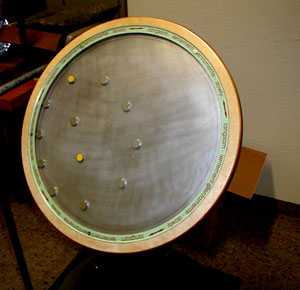
The "Forever Falling Magnets" exhibit.
Spin the disk and eddy currents pull the magnets up against gravity.
They then fall and make interesting orbits.
Colloquium for Sonoma State University, 27 October 2003
By Paul Doherty
What Physicists Do?
I have a great job for a physicist. I get to travel the world to explain physics to people.
I've done webcasts of eclipses in Turkey and Africa, webcasts in Antarctica. I created the Iron Science Teacher competition. I've appeared on David Letterman's program. I've written Children's books for Klutz Press, Chronicle Books and the Exploratorium.
Just to give you a sample of the kinds of things I do everyday I brought along some simple demonstration versions of magnetism exhibits I've helped to build at the Exploratorium.
Magnetism Exhibits
Introduction about going further
Silent Collisions, Collide magnets on a pencil. For 40 years I bounced magnets on a pencil until a seventh grade student opened my eyes to a world of possible experiments.
Freefall Magnets, Drop magnets on a horizontal rod and observe their friction free interaction.
Magnetic Atmosphere Model, a stack of magnets on a pencil models the behavior of atmospheres.
Magnets 3 vs 1 Feel the force between two film cans, one contains 3 magnets, the other contains 1 magnet and clay to make its mass identical.Magnets Round the Rim set two disk magnets to attract when rim to rim, try to make one orbit the other.
Quantitative force between two magnets versus distance, Use a digital scale to measure the force law between magnets.
Gaussian Accelerator, Magnets and steel ball bearings can be used to accelerate the balls.
Magnets as Compasses, magnetic fields
Where's North? Chinese Compass , Hang ten identical magnets and they will all point in the same direction.
Magnetic Poles
Magnetic Globe, Embed a neodymium magnet inside an earth globe to model the magnetic field of the earth.
Pierson Oscillator, One magnet can be used to levitate the edge of another magnet. This shows the need for replacing poles with magnetic field lines.
The invention of Neodymium Magnets. As physicists you can make discoveries that change the world. A Physics teachers your students can go on to make discoveries that change the world. Of course your students return 20 years later having gained 40 pounds, with less hair on their heads and more on their chins and say, "Hi Prof. Doherty, remember me?" My student Chris Thrush was on the team at GM research labs that invented neodymium magnets.
Eddy Currents
Eddy Current slowing , Snack, Drop a Neodymium Magnet down a copper tube or slot and it will slow due to the magnetic fields from eddy currents. At the museum we made the motion of the magnets visible by dropping them down a slot with one open side.
Forever Falling Magnets, allow neodymium magnets to slide on a rotating disk and they will make interesting orbits. One neat thing is that adding multiple magnets made neat sounds as they hit the edge of the exhibit.

Guided magnetic Roller, Roll a neodymium disk magnet down a roadway made of aluminum and eddy currents will steer the magnet along the roadway.
Floating in Copper, Eddy currents in thick copper can be used to slow down the motion of magnets so that human eye hand feedback can "fly " one magnet under another.
Drop a neodymium magnet onto copper chilled to liquid nitrogen temperatures. The eddy currents will repel the dropped magnet with a force greater than gravity.
Eddy current propagation in time. Gorazd Planinsic showed me an interesting exhibit in which a neodymium magnet is placed under a spinning aluminum disk. Iron filings placed on a plastic holder above the spinning disk show the time delay for the eddy currents to propagate through the spinning disk.
Diamagnetism
Repel a Grape, A torsional oscillator made from two grapes can be used to show that grapes are diamagnetic.
Repel a Flame, The paramagnetic attraction of a neodymium magnet for atmospheric oxygen can be used to repel an oxygen depleted flame by buoyancy effects.
Magnets in Fluids
Ferrofluid
Modern uses for magnetism
Magnetic Tape, Strips of cassette ape can be magnetized to show how digital computers work.
Magnetic Feedback, A pickup coil attached to an amplified speaker can create a feedback loop which can be modulated by inserting metals into the loop.
Barkhausen Effect, A Radio Shack Amplified Speaker and an iron core pickup coil, can be used to produce the barkhausen effect.
Electromagnetism
Stripped down generator, A magnet falling through a coil of wire can create enough current to light an LED.
Induction, A coil of wire driven by a radio can be used to drive the tape head of a cassette player.
Klutz Magnetism Book: Magnetic Magic by John Cassidy and Paul Doherty
Square Wheels: by Don Rathjen and Paul Doherty
|
Scientific Explorations with Paul Doherty |
|
27 October 2003 |